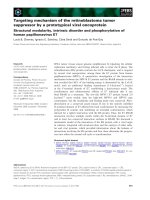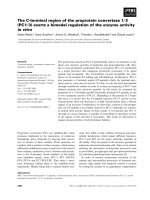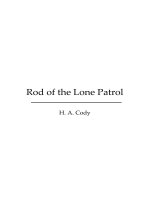Regulation of the TRIP BR1 proto oncoprotein a potential therapeutic target for human cutaneous and intracavitory proliferative lesions
Bạn đang xem bản rút gọn của tài liệu. Xem và tải ngay bản đầy đủ của tài liệu tại đây (2.61 MB, 180 trang )
REGULATION OF THE TRIP-BR1 PROTO-
ONCOPROTEIN—A POTENTIAL THERAPEUTIC
TARGET FOR HUMAN CUTANEOUS AND
INTRACAVITARY PROLIFERATIVE LESIONS
BY
ZHIJIANG ZANG
(MBBS, Kunming Medical College, China; MSc, National University of
Singapore, Singapore)
THESIS SUBMITTED
FOR THE DEGREE OF PHILOSOPHICAL DOCTOR OF SCIENCE
DEPARTMENT OF MEDICINE
NATIONAL UNIVERISTY OF SINGAPORE
2007
Zhijiang Zang Medicine, NUS
PhD. Thesis 2003-2007
2
ACKNOWLEDGEMENTS
I wish to express my deep appreciation to the following individuals who made this
work possible.
First of all, my sincerest and deepest gratitude to my mentor Prof. Stephen I-Hong
Hsu, for his guidance during my doctoral study. He provided a motivating,
enthusiastic, and critical atmosphere during the many discussions we had. His
constant support and encouragement, his inspiration and patience, his mentorship and
friendship are the key for me to be able to submit this thesis. I feel very privileged to
have worked with him and had a long journey with him together.
With a deep sense of gratitude, I want to thank my co-supervisors, Prof. Manuel
Salto-Tellez, who provided timely and valuable help at the crucial time.
I like to express my deepest gratitude to Dr. Lakshman Gunaratnam, Brigham and
Women's Hospital, for giving me excellent guidance, sharing valuable knowledge,
asking challenging questions, reading and revising this thesis and providing good
company. His experience and involvement is crucial for me to overcome many
obstacles I met in this research project.
I’d like to express my sincerest thanks to Prof. Joseph Vincent Bonventre, Robert H.
Chief, Renal Division, Brigham and Women's Hospital, Harvard Medical School, for
having me in his great lab during July 2005- July 2007. Thank him for allowing me to
Zhijiang Zang Medicine, NUS
PhD. Thesis 2003-2007
3
participate him lab meeting and present my data during this period of time. Thank him
for his sound advice and constructive comments on my project.
I wish to thank the lab members in the Renal Division, Brigham & Women Hospital
of Harvard Medical School for their inspiring discussions and valuable advices. I am
especially grateful to Dr. Jagesh Shah, Prof. Antonis S. Zervos, Dr. T akaharu
Ich imura, Dr. Benjamin Humphreys, Dr. Li-Li Hsiao, Dr .Won Han, Dr. Alice
Marie Sheridan, Dr. Dirk Hentschel, D r. Deguang Zhu and Dr. Vish al S. Vaidya.
I wish to thank Ms. Eileen O'Leary and Ms. Xiaoming Sun in Brigham & Women
Hospital of Harvard Medical School for assisting me in many different ways.
I would like to thank people in School of Medicine of National University of
Singapore, especially Prof. Bay Boon Huat, Ms. Stacy Tan, Ms. Geetha Sreedhara
Warrier and Ms. Malika Raguraman for their kind helps during the last four years in
NUS. Without the assistance from them and others that I did not mention the names,
my PhD candidature will not be smooth.
Special thanks to fellow colleague Jit Kong Cheong for his good company, friendship
and assistance during this long journey. I would like to also thank Susan Nasr who
spent a lot of time in reading and editing this thesis although she is busy with
preparing MCAT. I am grateful to all the members of the laboratory in Singapore: Dr.
Sim Khe Guan, Dr.Yang Maolin Christopher, Chui Sun Yap, Hajjah Shahidah Bte
Mohd Said who made the lab such a wonderful workplace and home.
Zhijiang Zang Medicine, NUS
PhD. Thesis 2003-2007
4
I am indebted to Dr. Tan Lai Yong & Lay Chin and Prof. Tan Kim Siang Luke for
their invaluable support, encouragement and friendship during 2001-2005 when I was
in Singapore.
I’d like to thank my wonderful wife Liyun Lai, who has been extremely
understanding and supportive of my studies. She has never complained although we
had to experience a lot of hardship when we are alone in overseas. Without her
sacrifice, it is totally impossible for me to focus on research. I thank my daughter, Yi
Zang, for giving me so much joy. Sorry for the countless weekends and holidays that I
could not accompany you and your mom during these four years. I love your two!
I thank my brother, Zhixin Hu and his wife, my parents-in-law, my aunty and her
family for their moral support.
Lastly, and the most importantly, I wish to thank my mother, Xixiu Zang and my
father Shufan Fu. They bore me, raised me, taught me, and loved me. Although my
mother is no longer with us, she is forever remembered. Her love is always in my
heart. I am sure she shares my joy and happiness in the heaven.
To my mother and father I dedicate this thesis.
Zhijiang Zang Medicine, NUS
PhD. Thesis 2003-2007
5
TABLE OF CONTENTS
Page
TITLE
1
ACKNOWLEDGEMENTS
2
TABLE OF CONTENTS
5
LIST OF PUBLICATIONS
11
LIST OF FIGURES & TABLES
12
LIST OF ABBREVIATIONS
16
ABSTRACT
19
CHAPTER ONE
GENERAL INTRODUCTION
1.1 TRIP-Br proteins
1.1.1 TRIP-Br protein family 21
1.1.2 Domain structure of the TRIP-Br Proteins 25
1.1.3 TRIP-Br proteins co-regulate transcriptional
activity of E2F-1/DP-1 24
1.1.4 TRIP-Br proteins interact with PHD zinc finger-
and /or the bromodomain- containing proteins
1.1.4.1 PHD zinc finger domain and proteins 26
1.1.4.2 Bromodomain and bromodomain-containing proteins 31
1.1.4.3 Interaction between PHD zinc finger/bromodomain
-containing transcription factors and TRIP-Br proteins 34
Zhijiang Zang Medicine, NUS
PhD. Thesis 2003-2007
6
1.1.4.4 Biological significance of the interaction between PHD
zinc finger/bromodomain proteins and TRIP-Br proteins 37
1.1.5 TRIP-Br1 is a CDK 4 interacting protein 38
1.1.6 TRIP-Br proteins interact with cyclin A 39
1.1.7 TRIP-Br proteins are novel cell cycle regulators 40
1.1.8 The integrator model of TRIP-Br protein function in cell
cycle regulation 41
1.2
TRIP-Br proteins and cancer
1.2.1 TRIP-Br1 and RBT1 locate at 19q13, a common amplicon
in human cancer 44
1.2.2 TRIP-Br proteins promote cell growth 45
1.2.3 TRIP-Br proteins are a family of oncogenes 46
1.2.4 The integrator function of TRIP-Br proteins and cancer 47
CHAPTER TWO
OBJECTIVES
49
CHAPTER THREE
EVALUATION OF THE TRIP-BR PROTEINS AS
CHEMOTHERAPEUTIC DRUG TARGET IN HUMAN CUTANEOUS AND
INTRACAVITARY HYPERPROLIFERATIVE LESIONS
2.1 Introduction 51
2.2 Material and methods
2.2.1 Materials 54
2.2.1.1 Decoy peptide 54
2.2.1.2 Cell culture 54
2.2.2 Methods
2.2.2.1 Generation and characterization of monoclonal and
polyclonal antibodies against hTRIP-Br proteins 55
2.2.2.2 Western blot for detection of TRIP-Br expression 55
2.2.2.3 In vitro and in vivo decoy peptide uptake assay by
flow cytometric analysis and confocal microscopy 55
Zhijiang Zang Medicine, NUS
PhD. Thesis 2003-2007
7
2.2.2.4 Cell cycle analysis 55
2.2.2.5 BrdU incorporation assay 56
2.2.2.6 Colony formation assay 57
2.2.2.7 Generation of nude mouse tumor xenograft models 57
2.2.2.8 Chick embryo chorioallantoic membrane (CAM)
tumor xenograft model establishment and validation 57
2.2.2.9 In vivo effect of peptide treatment on tumor growth 58
using the chick CAM model
2.2.2.10 Statistical analysis 59
2. 3 Results
2.3.1 TRIP-Br decoy peptides inhibit the proliferation of
CNE2, Ca Ski and MeWo cells in vitro 60
2.3.2 Tumors xenografts in the chick embryo CAM model are
accessible to the topically applied decoy peptide treatment 60
2.3.3 TRIP-Br decoy peptides inhibit the growth of CNE2-,
Ca Ski- and Me Wo-derived tumors in the chick embryo
CAM model 64
2.4 Discussion 66
CHAPTER FOUR
REGULATION OF TRIP-BR1 BY SERINE/
THREONINE PROTEIN PHOSPHATASE 2A
3.1 Introduction
3.1.1 Protein kinases and protein phosphatases 75
3.1.2 Protein phosphatase 2A (PP2A)
3.1.2.1 Subunit composition, localization and distribution 76
3.1.2.2 Biological role of PP2A
3.1.2.2.1 Regulation by PP2A via protein-protein interaction 81
Zhijiang Zang Medicine, NUS
PhD. Thesis 2003-2007
8
3.1.2.2.2 PP2A and cell cycle 83
3.1.2.2.3 PP2A and tumorigenesis 84
3.2 Materials and methods
3.2.1 Materials
3.2.1.1 Plasmid DNA 87
3.2.1.2 Biochemical reagents 87
3.2.2 Methods
3.2.2.1 Cell culture and maintenance 88
3.2.2.2 Expression and purification of GST fusion proteins 89
3.2.2.3 GST pull-down assay 90
3.2.2.4 Silver staining 90
3.2.2.5 Coomassie Blue staining 91
3.2.2.6 Liquid chromatography/mass spectrometry 91
3.2.2.7 Immunoprecipitation assay 92
3.2.2.8 Serine/threonine protein phosphatase activity assays 92
3.2.2.9 Indirect immunofluorescence staining of cells 93
3.2.2.10 Subcellular fractionation 93
3.2.2.11 Co-localization study of TRIP-Br1 and PP2A-Bα 94
3.2.2.12 DNA and siRNA transfection procedures 94
3.2.2.13 Preparation of proteins from tissue culture 94
3.2.2.14 Protein quantitation 95
3.2.2.15 Western blot for protein immunodetection 95
3.2.2.16 Extraction of total cellular RNA 96
3.2.2.17 Reverse transcription of RNA 96
3.2.2.18 Gel electrophoresis of DNA products 97
Zhijiang Zang Medicine, NUS
PhD. Thesis 2003-2007
9
3.2.2.19 Real time-RCR 97
3.2.2.20 Luciferase assays 98
3.3 Results
3.3.1 Identification of the Bα and Bδ subunits of serine/threonine
protein phosphatase 2A as potential interactors of TRIP-Br1
3.3.1.1 Expression and purification of glutathione S-transferase
mouse TRIP-Br1 fusion protein 99
3.3.1.2 Probing mammalian cellular protein extracts with GST-
mTRIP-Br1 102
3.3.1.3 Mass spectrometric analysis 105
3.3.2 TRIP-Br1 associates with catalytically active PP2A holoenzyme
in vitro
3.3.2.1 GST-mTRIP-Br1 binds to the PP2A holoenzyme 110
comprising the A/Bα/C subunits
3.3.2.2 Catalytically active PP2A holoenzyme associates with
GST-mTRIP-Br1 114
3.3.3 Endogenous human TRIP-Br1 associates with PP2A holoenzyme
in vivo 116
3.3.4 Endogenous TRIP-Br1, a cytoplasmic dominant protein,
co-localizes with the Bα subunit of PP2A 120
3.3.5 TRIP-Br1 is a serine-phosphorylated protein 128
3.3.6 Okadaic acid treatment alters the level of serine-phosphorylated
and total TRIP-Br1 protein 132
3.3.7 Transcriptional silencing of the PP2A catalytic subunit decreases
the level of TRIP-Br1 protein 137
3.3.8 Overexpression of the PP2A-C subunit increases the level of
TRIP-Br1 protein and TRIP-Br1 co-activated E2F1/DP1transcription 141
3.4 Discussion 150
Zhijiang Zang Medicine, NUS
PhD. Thesis 2003-2007
10
CHAPTER FIVE
CONCLUDING REMARKS 162
REFERENCES 166
Zhijiang Zang Medicine, NUS
PhD. Thesis 2003-2007
11
L
L
I
I
S
S
T
T
O
O
F
F
P
P
U
U
B
B
L
L
I
I
C
C
A
A
T
T
I
I
O
O
N
N
S
S
PAPERS
1. Zang ZJ, Sim KG, Cheong JK, Yang MC, Yap CS, Hsu SI (2007) Exploiting the
TRIP-Br Family of Cell Cycle Regulatory Proteins as Chemotherapeutic Drug Targets
in Human Cancer. Cancer Biology & Therapy 2007 May 3;6(5)
2. Sim KG, Zang Z, Yang CM, Bonventre JV, Hsu SI (2004) TRIP-Br Links E2F to
Novel Functions in the Regulation of Cyclin E Expression During Cell Cycle
Progression and in the Maintenance of Genomic Stability Cell Cycle 3:1296-304
3. Zang ZJ, et al. Regulation of TRIP-Br1 by serine/threonine protein phosphatase
2A (In preparation)
CONFERENCE PAPERS
Zang Z, et al. Proof-of-principal studies of peptides that antagonize the integrator
function of TRIP-Br transcription factors for the treatment of cutaneous and
intracavitary lesion. (Poster presentation), ASN 2006 Annual Meeting, San Diego,
California; Nov 17-22, 2006
Zang Z, et al. Exploiting the TRIP-Br Family of Cell Cycle Regulatory Proteins as
Chemotherapeutic Drug Targets in Human Cancer. (1 of only 12 Posters Selected for
Presentation), Immunology and skin disease: New Perspective. Boston, MA. Mar 22-
24, 2007
Zhijiang Zang Medicine, NUS
PhD. Thesis 2003-2007
12
L
L
I
I
S
S
T
T
O
O
F
F
F
F
I
I
G
G
U
U
R
R
E
E
S
S
&
&
T
T
A
A
B
B
L
L
E
E
S
S
Figure Description Page
Figure 1.1
Comparison of the motif structure of five classic members
(TRIP-Br1, TRIP-Br2, RBT1, CDCA4 and TARA) and
one
non-classical member of TRIP-
Br protein member (SERTAD
4)
23
Figure 1.2 The predicted cross-brace (C
4
HC
3
)
model of the PHD zinc
finger domain of Pygopus
30
Figure 1.3
The NMR solution structure of the P/CAF bromodomain
(blue) in complex with an lysine-acetylated peptide (green)
derived from HIV-1 Tat at residue K50 (SYGR-AcK-
KRRQR)
33
Figure 1.4 The integrator model of TRIP-Br protein function 43
Figure 2.1 Endogenous TRIP-Br1 and TRIP-
Br2 protein expression in
represent
ative human cancer cell lines detected by Western
blot analysis
62
Figure 2.2 In vitro evaluation of the effect of exposure to TRIP-
Br
decoy peptides
63
Figure 2.3
Chick embryo chorioallantoic membrane (CAM) cancer
model validation
66
Figure 2.4 Comparison of nude mouse and
chick embryo chorioallantoic
membrane (CAM) xenograft models
67
Figure 2.5
Histograms showing tumor weight after topical
administration of decoy peptides on (A) CNE2-, (B) MeWo-
,
(C) Ca Ski- and (D) MeWo- cell-derived tumors in the c
hick
embryo CAM model
69
Figure 3.1 Structure of PP2A holoenzyme
79
Figure 3.3.1 Expression and purification of glutathione S-
transferase
mouse TRIP-Br1 fusion proteins
101
Zhijiang Zang Medicine, NUS
PhD. Thesis 2003-2007
13
Figure 3.3.2 Endogenous TRIP-
Br1 expression in a panel of human
kidney epithelial cell lines
103
Figure 3.3.3 Visualization of GST-mTRIP-Br1-
bound proteins in HEK
293 cellular extracts by silver staining
104
Figure 3.3.4 The identified peptides (highlighted in green) by l
iquid
chromatography/mass spectrometry
108
Figure 3.3.5 Alignment of the protein sequences of PP2A-
B family
members, Bα and Bδ
109
Figure 3.3.6 GST-mTRIP-
Br1 fusion protein pulls down PP2A
holoenzyme in HEK 293 cells in vitro
112
Figure 3.3.7 GST-mTRIP-
Br1 pulls down the PP2A holoenzyme
comprising the A/Bα/C subunits in 769-P cells in vitro
113
Figure 3.3.8a GST-mTRIP-Br1 pulls down catalytically active PP2A 115
Figure 3.3.8 b Catalytically active PP2A pulled down by GST-mTRIP-
Br1
is sensitive to okadaic acid
115
Figure 3.3.9 Endogenous PP2A holoenzyme co-immun
oprecipitates with
endogenous TRIP-Br1 protein in HK2 cells
118
Figure 3.3.10 Endogenous PP2A holoenzyme co-
immunoprecipitates with
endogenous TRIP-Br1 protein in 786-O cells
119
Figure 3.3.11 Subcellular localization of endogenous TRIP-Br1 in 786-O
cells.
124
Figure 3.3.12 Subcellular fractionation indicates
a predominantly
cytoplasmic distribution of endogenous TRIP-Br1 and PP2A-
Bα protein in HK2 and 786-O cells
124
Figure 3.3.13 Endogenous TRIP-
Br1 protein mainly expresses in the
cytosolic fraction of NIH3T3 and WI38 cells
125
Zhijiang Zang Medicine, NUS
PhD. Thesis 2003-2007
14
Figure 3.3.14 Specificity of the anti-TRIP-Br1 mouse monoclonal antibody
125
Figure 3.3.15 Viral vector-encoded FLAG-TRIP-
Br1 proteins express in
the nucleus of 769-P cells
126
Figure 3.3.16 Exogenous HA-TRIP-
Br1 protein expresses in the nucleus of
cos-7 cells
126
Figure 3.3.17 PP2A-Bα and TRIP-Br1 co-
localize predominantly in the
cytoplasm, with co-staining in nucleus of HK2 and 786-
O
cells
127
Figure 3.3.18 Predicted phosphorylation sites on full-length human TRIP-
Br1 protein.
130
Figure 3.3.19 Endogenous TRIP-Br1 protein is a serine-
phosphorylated
protein.
131
Figure 3.3.20 Okadaic acid treatment increases the level of serine-
phosphorylated TRIP-Br1 but decreases the level of total
TRIP-Br1 protein.
135
Figure 3.3.21
Okadaic acid treatment does not change the subcellular
distribution of TRIP-Br1
136
Figure 3.3.22 Knocking down PP2A-C subunit decreases
the level of
TRIP-Br1 protein
139
Figure 3.3.23 Knocking down PP2A-C subunit
does not alter the level of
TRIP-Br1 mRNA expression
140
Figure 3.3.24 Overexpression of the PP2A-C subunit increases
the level of
TRIP-Br1 protein
144
Figure 3.3.25 Overexpression of the PP2A-
C subunit does not change the
level of TRIP-Br1 mRNA
146
Figure 3.3.26 Overexpression of the PP2A-C subunit decreases the
level of
serine-phosphorylated TRIP-Br1
147
Figure 3.3.27 Overexpression of PP2A-C subunit increases TRIP-Br1 co-
activated E2F1/DP1 transcription
149
Zhijiang Zang Medicine, NUS
PhD. Thesis 2003-2007
15
Table Description Page
Table 1.1 Summary on the nomenclature,
protein cellular localization,
tissue expression and function properties of TRIP-
Br protein
family
24
Table 1.2 Representative bromodomain-containing
proteins in yeast
and mammals
33
Table 1.3 PHD zinc finger- and/or bromodomain-containing
proteins
that are known to interact with TRIP-
Br proteins and their
structure features and proposed functions
36
Table 1.4 Known oncogenes in TRIP-Br family 48
Table 3.1
Nomenclature and distribution of regulatory B-type subunits
80
Table 3.2 The proteins identified from the unique 55 kD band by l
iquid
chromatography/mass spectrometry
107
Zhijiang Zang Medicine, NUS
PhD. Thesis 2003-2007
16
L
L
I
I
S
S
T
T
O
O
F
F
A
A
B
B
B
B
R
R
E
E
V
V
I
I
A
A
T
T
I
I
O
O
N
N
S
S
AIRE Autoimmune Regulator
APC Adenosis Polyposis Coli
ATCC American Tissue Culture Collection
ATRX Α-Thalassemia, mental Retardation, X-linked
Br-dUTPs Bromolated deoxyuridine triphosphate nucleotides
CAK Cdk-Activating Kinase
CAM Chorioallantoic Membrane
CaMkIV CaM Kinase IV
CBP Cyclic-AMP-response element Binding Protein
CDK Cyclin-Dependent Kinase
CK2 Casein Kinase 2
CO
2
Carbon Dioxide
DIG Digoxigenin
DMEM Dulbecco’s Modified Eagle’s Medium
DMSO Dimethyl Sulphoxide
dNTPs Deoxyribonucleotide Triphosphates
DTT Dithiothreitol
EMSA Electro-mobility Shift Assay
EtBr Ethidium Bromide
FACS Fluorescence-Activated Cell Sorting
FBS Fetal Bovine Serum
Gcn5 General Control Non-derepressible 5
GFP Green Fluorescent Protein
GST Glutathion-S-Transferase
Zhijiang Zang Medicine, NUS
PhD. Thesis 2003-2007
17
HAT Histone Acetyltransferase activity
HEAT-like Huntingtin-Elongation-A subunit-TOR-like
IP Immunoprecipitation
IVT In vitro translation
LB Luria-Bertani
MCAP Mitotic Chromosome-Associated Protein
Met Methionine
MPF M-phase-Promoting Factor
MS Mass Spectroscopy
NLS Nuclear localization signal
OA Okadaic Acid
PAGE Polyacrylamide Gel Electrophoresis
PCAF P300/CBP-Associated Factor
PCR Polymerase Chain Reactions
PEST Proline-rich Sequence
PHD Plant Homeodomain
PHF Plant Homeodomain-like Finger Protein
Plx1 Polo-like Kinase
PMEFs Primary Mouse Embryonic Fibroblasts
PP2A Protein Phosphatase 2A
PVDF Polyvinylidene difluoride
RB Retinoblastoma
RBCC RING finger-B Box-coiled Coil
RBT1 Replication Protein Binding Trans-acitivtor1
RE Restriction Enzyme
RPA Replication Protein A
RTS Rubinstein-Taybi Syndrome
Zhijiang Zang Medicine, NUS
PhD. Thesis 2003-2007
18
SAGA Spt-Ada-Gcn5-Acetyltransferase
SDS Sodium Dodecyl Sulphate
siRNAs Small interfering RNAs
TBE Tris-Borate EDTA
TRIP-Br
Transcriptional Regulator Interacting with the PHD-
Bromodomain containing proteins
UAS Upstream Activation Sequence
UV Ultra-Violet
WSTF William–Beuren Syndrome Transcription Factor
Zhijiang Zang Medicine, NUS
PhD. Thesis 2003-2007
19
A
A
B
B
S
S
T
T
R
R
A
A
C
C
T
T
The TRIP-Br proteins are a novel family of transcriptional regulators that function at
E2F1-responsive promoters to integrate signals provided by PHD zinc finger- and/or
bromodomain-containing transcription factors. Multiple members of TRIP-Br family
are demonstrated to be oncogenes. We have previously reported that antagonism of
the TRIP-Br integrator function by synthetic decoy peptides that compete with TRIP-
Br1/2 for binding to PHD zinc finger- and/or bromodomain-containing transcription
factors inhibit the growth of human osteosarcoma cell line U2OS through the
transcriptional downregulation of a subset of endogenous E2F1-responsive genes. In
this study, we demonstrated that antagonism of the interactor function TRIP‑Br1/2
by these synthetic decoy peptides elicited an anti-proliferative effect in representative
human nasopharyngeal (CNE2), cervical (Ca Ski) and melanoma (MeWo) cancer cell
lines in vitro as well as in corresponding chick embryo chorioallantoic membrane
(CAM) tumor xenografts in vivo, suggesting that TRIP‑Br1 may represent a novel
therapeutic target for the treatment of human cutaneous and intracavitary
hyperproliferative lesions. To further understand the regulation of this potential
therapeutic target, GST-mTRIP-Br1 fusion protein was used as “bait” to mix with
HEK293 whole cell lysate to identify cellular interacting proteins. Mass spectroscopy
identified serine/threonine protein phosphatase 2A (PP2A) Bα and Bβ regulatory
subunit as TRIP-Br-1 interactors. GST pull-down, co-immunoprecipitation and
immunofluorescence staining independently confirmed the interaction between
endogenous PP2A and TRIP-Br1. Immunoprecipitation of TRIP-Br1 protein followed
by immunodetection of phosphoserine residues with anti-phosphoserine antibody
demonstrated that TRIP-Br-1 is a serine-phosphorylated protein. Inhibition of PP2A
Zhijiang Zang Medicine, NUS
PhD. Thesis 2003-2007
20
activity by okadaic acid or transcriptional silencing of PP2A catalytic subunit resulted
in an increase in serine phosphorylated TRIP-Br1 and a decrease in steady-state level
of TRIP-Br1 protein. Furthermore, overexpression of the PP2A-C subunit increased
the TRIP-Br1 protein level and TRIP-Br1 co-activated of E2F1/DP1 transcription.
These results suggest that PP2A holoenzyme ABαC associates with TRIP-Br1 in vitro
and in vivo in mammalian cells. The level of TRIP-Br1 protein is positively regulated
by PP2A. In summary, our data indicates that antagonizing the integrator function of
TRIP-Br proto-oncoprotein may represent important chemotherapeutic drug target for
superficial cutaneous and intracavitary hyperproliferative lesions. The protein level of
TRIP-Br1 is positively regulates by serine/threonine protein phosphatase 2A, via
dephoshrlation of serine residue(s) on TRIP-Br1. Uncovering the mechanism of
TRIP-Br protein regulation will facilitate the application of therapeutic strategies
targeting TRIP-Br proteins in human diseases.
Zhijiang Zang Medicine, NUS
PhD. Thesis 2003-2007
21
C
C
H
H
A
A
P
P
E
E
R
R
O
O
N
N
E
E
G
G
E
E
N
N
E
E
R
R
A
A
L
L
I
I
N
N
T
T
R
R
O
O
D
D
U
U
C
C
T
T
I
I
O
O
N
N
1.1 TRIP-Br proteins
1.1.1 TRIP-Br protein family
TRIP-Br (Transcriptional Regulator Interacting with the PHD-Bromodomain) protein
family is a novel family of proteins that function in both gene transcriptional
regulation and cell cycle progression. It comprises four structurally and functionally
related mammalian proteins (TRIP-Br1, TRIP-Br2, RBT1 and CDCA4) and a
Drosophila homologue, TARA. Murine TRIP-Br1 (p34
SEI-1
/SEI-1/SERTAD1) was
originally identified from a mouse whole embryo cDNA library based on its unique
ability to interact with the composite PHD-bromodomain of the transcription factor
KRIP-1 (KRAB associated protein, also known as TIF1β or KAP 1) in a yeast two-
hybrid screen (Hsu et al., 2001). TRIP-Br1 is identical to p34SEI-1, which was cloned
using the cyclin-dependent kinase (CDK) inhibitor INK4 family member p16
INK4a
as
the “bait” (Sugimoto et al., 1999). As TRIP-Br2 (SE1-2/SERTAD2) was
demonstrated to be structurally and functionally homologous to TRIP-Br1, they were
designated as a novel family of proteins (Hsu et al., 2001). CDCA4/Hepp/SEI-3 was
identified as a gene specifically expressed in hematopoietic progenitor cells as
opposed to hematopoietic stem cells (Abdullah et al., 2001; Cho et al., 2000).
Subsequently, RBT1 (SERTAD3) was cloned in a yeast two-hybrid screen employing
the replication protein A (RPA) 32 subunit as the “bait.” Recently, SERTAD4 was
reported to be a non-classical member of this protein family, as it only harbors two of
the four characteristic domains of TRIP-Br protein family (Bennetts et al., 2006).
Zhijiang Zang Medicine, NUS
PhD. Thesis 2003-2007
22
Along with the Drosophila protein taranis (TARA), a novel member of the trithorax
group of regulatory molecules isolated in a screen for functional partners of the
homeotic loci, members of the TRIP-Br family share at least 4 characteristic highly
evoluationarily conserved domains (Figure 1.1) (Calgaro et al., 2002).
BLAST analysis shows that sequences for CDCA4 and TRIP-Br2 orthologues are
present in a range of species including human, mouse, pufferfish, fugu, zebrafish, etc;
while orthologues for RBT1 and TRIP-Br1 have only been identified from mammalian
sequences, suggesting that the RBT1 and TRIP-Br1 genes exist only in mammals
(Bennetts et al., 2006). A comparison of nomenclature, protein cellular localization,
tissue expression and protein functions of the TRIP-Br family members are listed in
Table 1.1.
Zhijiang Zang Medicine, NUS
PhD. Thesis 2003-2007
23
Figure 1.1: Comparison of the motif structure of five classic members (TRIP-Br1,
TRIP-Br2, RBT1, CDCA4 and TARA) and one non-classical member of TRIP-
Br protein family (SERTAD 4). Figure modified from Bennetts et al., 2006.
Zhijiang Zang Medicine, NUS
PhD. Thesis 2003-2007
24
Table 1.1: Summary on the nomenclature, protein cellular localization, tissue
expression and functional properties of TRIP-Br protein family.
G
G
e
e
n
n
e
e
C
C
e
e
l
l
l
l
u
u
l
l
a
a
r
r
L
L
o
o
c
c
a
a
l
l
i
i
z
z
a
a
t
t
i
i
o
o
n
n
T
T
i
i
s
s
s
s
u
u
e
e
E
E
x
x
p
p
r
r
e
e
s
s
s
s
i
i
o
o
n
n
P
P
r
r
o
o
t
t
e
e
i
i
n
n
F
F
u
u
n
n
c
c
t
t
i
i
o
o
n
n
(
(
s
s
)
)
Human TRIP-
Br1 (p34
SEI-1
,
SERTAD1)
Predominantly
nuclear based on
exogenous tagged
protein
expression
pattern (Lai et al.,
2007; Sugimoto
et al,1999)
Ubiquitously expressed in
various human adult
tissues except thymus
(Sugimoto et al,1999)
Associates with PHD-
bromodomain-containing
proteins to regulate E2F1/DP1
mediated transcription via
interaction with DP1 (Hsu, et
al, 2001); regulates cyclin D1-
CDK4 complex activity by
antagonizing the inhibitory
action of the tumor suppressor
p16
INK4α
, leading to stimulation
of cyclin D1-cdk4 kinase
activity (Sugimoto et al,1999)
Human
TRIP-Br2
(SEI-2,
SERTAD2)
Predominantly
nuclear with
some cytoplasmic
staining based on
exogenous tagged
protein
expression
pattern (Lai et al.,
2007)
Ubiquitously expressed at
similar levels in the
majority of human adult
tissues and during
development, with
slightly higher level in
thymus and peripheral
blood leukocytes (Nagase
et al., 1997)
Associates with PHD-
bromodomain-containing
proteins to activate E2F1/DP1
mediated transcription via
interaction with DP1 (Hsu, et
al, 2001)
Human
CDCA4
(TRIP-Br3,
Hepp, SEI-3)
Predominantly
nuclear based on
exogenous tagged
protein
expression
pattern (Lai et al.,
2007)
Highly expressed in
fertilized egg/oocyte,
throughout mouse
embryongenesis (E6.5–
10.5), adult mouse
thymus, bone and B- and
T-cells (Lai et al., 2007)
Represses E2F1-dependent
transcriptional activation and
cell proliferation
(Hayashi et al., 2006)
Human
RBT1
(SERTAD3
)
)
Predominantly
nuclear based on
exogenous tagged
protein
expression
pattern (Cho et
al., 2000;
Darwish et al.,
2007)
Ubiquitous expression
in all human adult tissues
examined (Cho et al.,
2000; Darwish et al.,
2007)
Potentiates E2F-1
transcriptional activity and
positively regulate cell
proliferation (Cho et al., 2000;
Darwish et al., 2007)
Human
SERTAD4
Unknown High expression levels in
human adult epidermal
tissues and in digits
(Bennetts et al., 2006)
Unknown
Drosophila
TARA
Unknown Broad expression
throughout Drosophila
embryogenesis. Different
staining pattern of α- and
β- isoforms (
Calgaro et
al., 2002)
Proposed to modify expression
of the homeotic loci by binding
and activating bromodomain-
containing trxG proteins to
promote an active chromatin
state
(Calgaro et al., 2002)
Zhijiang Zang Medicine, NUS
PhD. Thesis 2003-2007
25
1.1. 2 Domain Structure of the TRIP-Br Proteins
Similarities among the above five mammalian TRIP-Br/TRIP-Br-like proteins are
based on the presence of multiple highly evolutionarily conserved domains. As
showed in Figure 1.1, these regions include an N-terminal basic cyclin A-binding
motif (containing a putative nuclear localization signal), a novel uncharacterized
motif termed SERTA (SEI-1, RBT1 and TARA), a PHD zinc finger- and/or
bromodomain-containing protein binding motif, and a conserved acidic C-terminal
domain (shown to mediate a transactivation function for TRIP-Br1 and TRIP-Br2)
(Calgaro et al., 2002). All four domains are highly evolutionarily conserved across
mammalian species. The SERTA motif is the longest among them, consisting of
approximately forty-eight amino acids. This domain may serve as a protein-protein
interaction domain for the binding of TRIP-Br1 to CDK4 (see Table 1.1) involved in
the regulation of the activity of the cyclin-D1/CDK4/p16
INK4α
complex, which
promotes cell cycle progression in early G
1
(Sugimoto et al., 1999). The putative
cyclin A-binding motif in the TRIP-Br proteins family was suggested based on the
significant homology of this domain in the TRIP-Br1 and TRIP-Br2 proteins with the
cyclin A binding motif in the E2F-1 transcriptional activator (Hsu et al., 2001). The
binding TRIP-Br1/2 with cyclin A in vitro and in vivo has been confirmed
experimentally (S.I. Hsu, unpublished data). The C-terminal region of TRIP-Br
proteins is rich in acidic amino acids; recruitment of this region to a target promoter
activates transcription (Hsu et al., 2001). The PHD zinc finger- and bromodomain-
interacting motif is a unique motif that allows TRIP-Br proteins to physically interact
with a host of PHD zinc finger- and/or bromodomain-containing proteins that play
important roles in transcription regulation and chromatin remodeling. Figure 1.1









